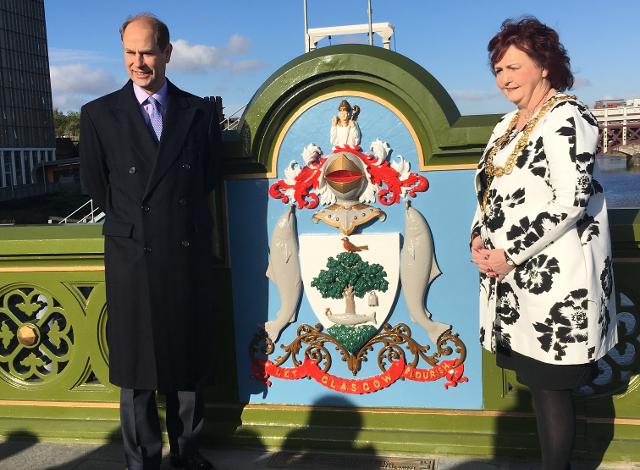- Glasgow City Council
- > News Archive
- > News Archive 2016
- > October 2016
- > Albert Bridge receives Royal recognition for restoration
Albert Bridge receives Royal recognition for restoration
Glasgow's historic Albert Bridge received the Royal seal of approval today (Thursday, 13 October) when HRH The Earl of Wessex paid a visit following the bridge's £3.4m restoration.
The Albert Bridge originally opened in June 1871 and cost £62,328. It is named after Prince Albert, The Earl of Wessex's Great, great, great grandfather.
It was the third road bridge built over the River Clyde in Glasgow, following the Victoria Bridge and Glasgow Bridge.
Glasgow City Council appointed Balfour Beatty to restore the 145 year old Category A listed Victorian structure and bring it back to its original form. Work began in May 2015 with completion earlier this year.
The £3.4m restoration included the complete refurbishment of the metalwork, restoring and repainting the Glasgow City and heraldic crests, replacing the damaged parapets and installing new ornate street lamps to match, as close as possible, the original gas lamp standards - a feature of the original construction.
A plaque commemorating its restoration was unveiled by HRH The Earl of Wessex, after meeting with and speaking to those directly involved in the project.
Bailie Elaine McDougall, the council's Executive Member for Transport, Environment and Sustainability, said: "The restoration of the Albert Bridge is remarkable.
"Glasgow is a city built on our reputation for engineering and we are committed to protecting our heritage as much as we possibly can.
"This is a 145 year old structure of significant historical importance and I'm delighted that the multi-million pounds investment by the city council to bring it back to its original form has been so successful.
"Restoring a bridge of this size, scale and age is no easy task and yet the results are amazing.
"Everyone involved in the project should be very, very proud."
There were four previous bridges at this site (the current bridge being number five).
Bridge No. 1: 1794 to 1795 - Five arches, 400ft length, 26ft wide. Foundations were not adequate and the bridge washed away in a flood in 1795.
Bridge No. 2: 1803 to 1834 - Replacement wooden footbridge, built slightly upstream. Length 340ft, with eight supporting piers. Designed by Peter Nicholson, the author of The Principles of Architecture. Admired for simplicity of construction and light appearance.
Bridge No. 3: 1829 to 1868 - Opened 1834 and called Old Hutchestown Bridge. Engineer Robert Stevenson - grandfather of Robert Louis Stevenson. Founded on 9inch square timber piles, it was 16ft long, five arches, and 35ft wide. Increased water flow due to removal of 2nd weir resulted in scouring foundations and the bridge was demolished 1868.
Bridge No. 4: 1868 to 1871 - Temporary wooden accommodation bridge on downstream side.
Bridge No. 5: 1871 to present day. Engineer R. Bell & D. Miller of Glasgow.
The Albert Bridge links the Saltmarket in the city centre with Crown Street on the south side.
Standing on concrete piers and abutments filled with cast iron caissons, the foundations are sunk some 86ft below water level. It has three curved arch spans, 410ft length, 60ft wide. The longest arch span is 114ft, with 17ft 5inches headroom clearance to river.
It has eight arched wrought iron riveted girders. Piers are 11ft wide and are faced on the outside with white (now grey) Scottish granite. The arch ribs are masked by cast iron spandrels, filled in with panels of scroll work and armorial shields including the royal coat of arms and those of various local trades.
A cast iron cornice is fixed to the main edge girder and surmounted by a massive ductile iron parapet, with panels at the centre of the bridge bearing the ancient arms of the City of Glasgow.
The ductile iron parapets are terminated with imposing granite pedestals and bearing roundels with guilded sculpted heads of Queen Victoria and Prince Albert, facing the river, on the four corners of the bridge.
Peter Bryce, Engineering Officer for Glasgow City Council who worked on the Albert Bridge restoration project, said: "As a chartered civil engineer I've been fortunate enough to have worked on various structural projects throughout Glasgow, preparing contracts and supervising construction works.
"My grandfather was a stonemason and worked on several bridges in Glasgow. According to my father he also worked on the Albert Bridge.
"I remember when I was quite young, about ten years old, I was walking over the bridge with my father when he told me about what his own father had done.
"I think the way the Albert Bridge was first built is really fascinating. She really is like a work of art and is in fantastic shape for her age.
"It was a privilege to be involved and to see the bridge today, looking as she does, makes it all worthwhile."
Stephen Scott, Balfour Beatty's Regional Managing Director for Central Scotland, said: "We were honoured to welcome His Royal Highness, The Earl of Wessex, to Albert Bridge today to celebrate with him and the local community the restoration of this iconic bridge.
"We were pleased to not only reinvigorate the much loved Albert Bridge but also to reaffirm our long-standing commitment to the development of Glasgow through supporting local employment opportunities."
NOTES TO EDITORS:
Attached below is a media pack for background to the work and the bridge. The photos, taken by Peter Bryce, are available for use. Please contact Vicky Bond on 0141 287 3773 or vicky.bond@glasgow.gov.uk to arrange.






